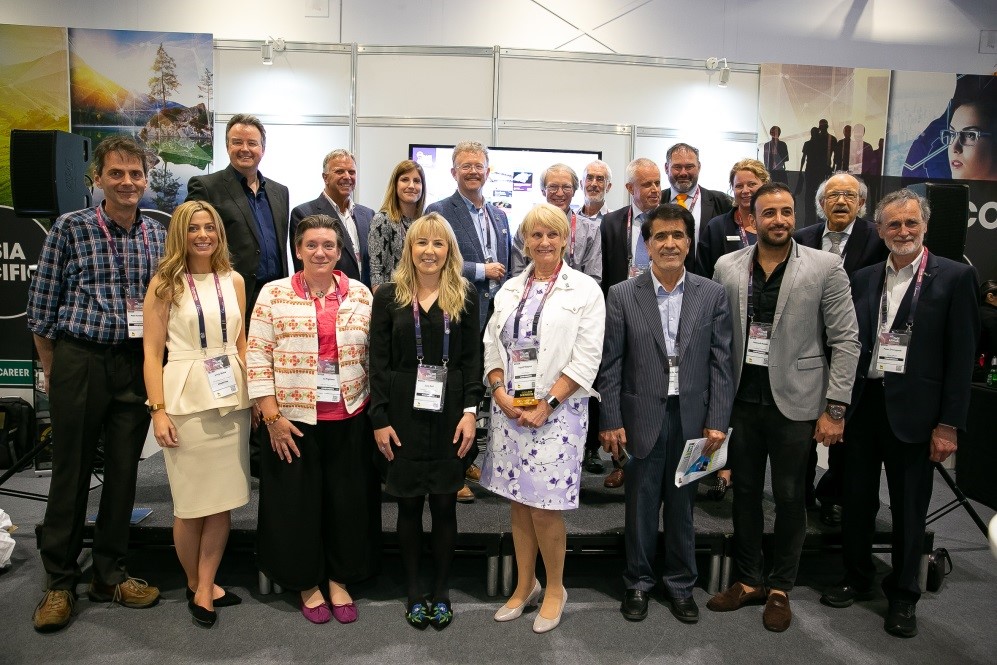Celebrating 25 Years of Petroleum Geoscience
Over the last 25 years, Petroleum Geoscience has been publishing leading research papers on exploration and development of sub-surface hydrocarbon resources and related themes in applied geoscience. The journal is a joint enterprise between the Geological Society of London (GSL) and the European Association of Geoscientists and Engineers (EAGE), published by the GSL Publishing House. The first issue was released in February 1995 with founding Editors Andrew Hurst and Tony Spencer at the helm.
On the opening evening of the 81st EAGE Conference and Exhibition, held at ExCel London, past and present editors, authors and contributors came together to celebrate Petroleum Geoscience’s special birthday. The reception was hosted by Philip Ringrose (Chief Editor), with speeches from Andrew Hurst (Founding Editor), Ingrid Magnus (Publication Officer) and Maggie Simmons (Head of GSL Editorial Development). Thank you to all those who attended and joined us in a toast to the last 25 years of Petroleum Geoscience.

Image courtesy of EAGE
What has changed in 25 years?
The topics and themes addressed within Petroleum Geoscience have been recognisable and fairly constant over this period (seismic imaging, stratigraphy, tectonics, basin analysis, reservoir modelling, etc.), but what has changed most are the advances in the techniques applied. Seismic imaging has moved on in leaps and bounds (e.g. waveform analysis and imaging), computer simulations now employ multi-physics analyses to multi-million cell models and the scales of analysis now go from the nanoscale (e.g. pore imaging) well past the basin scale to crustal-scale tectonic analysis.
Hopefully, careful geological observation of rock samples (at outcrop or in core) is still a foundation for any geoscience discipline, but the analytical methods used to take those observations into analysis and interpretation have moved on in leaps and bounds. If you have a moment, take a look at back issues of Petroleum Geoscience to see how this branch of Earth science has moved on over the last 25 years.
Looking to the future
We are pleased to announce that, during its 25th anniversary year, Petroleum Geoscience has decided to introduce a new series of papers on the theme of Energy Geoscience.
The Journal already publishes papers on geoscience aspects of energy storage, CO2 storage and geothermal energy, although our current content is mainly research related to hydrocarbon exploration and production. Research focused on new and emerging topics, such as cyclic storage of gas or geothermal energy, will represent an increasing fraction of the Journal’s coverage and deserve a more specific home. By introducing the Energy Geoscience Series, we hope to create a channel for the anticipated growth in non-petroleum related aspects of geoenergy and applied earth science.
We continue to invite papers on any aspect of geoenergy and applied earth science, but now authors are able to choose between submission under Energy Geoscience alongside the traditional categories under Petroleum Geoscience or one of the more specific Thematic Set topics we choose to run from time to time.
Despite this important and stimulating interest in new forms of energy, the use of hydrocarbons remains essential to human society, and novel and innovative papers on the geoscience of petroleum (derived from ‘rock oil’ in Greek) will continue to be a vital part of our geoscience portfolio. We look forward to receiving a continuing stream of high-quality research papers across all aspects of applied geoscience.
PESGB members can subscribe to Petroleum Geoscience at a preferential rate of £25 (online access) or £47 (online access + print), visit www.ges-gb.org.uk/media-archive/publication/petroleum-geoscience-journal to subscribe

